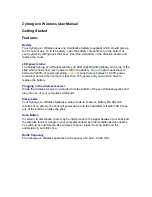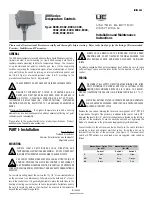
Operation
With a ValveLink8.2, a researcher can turn valves on and off using:
• front-panel manual pushbuttons
• digital inputs
• analog input
• or USB port and software (see USB chapter).
LED lights on the front of the controller indicate valve status. The
ValveLink8.2 sends an analog voltage out the "event marker" BNC on the
front panel every time a valve is opened or closed. This marker can be
recorded using a single channel for a permanent record of valve activity
synchronized with a physiological recording. Also, a spill sensor is
monitored to close all valves in case a liquid overflow happens. This can
save precious reagents and protect valuable microscope equipment in
the event of a spill. With no power switch, the ValveLink8.2 can be put
to sleep by holding the "Mode/Sleep" button for three seconds. Press the
same button to wake from sleep. Descriptions of these features follow...
Manual Control
Each press of a front-panel pushbutton toggles its valve on and off subject
to Mode settings described in the next chapter. The buttons can be pressed
even when the ValveLink8.2 is being controlled by an external device or
computer. Press the "Mode/Sleep" button for three seconds to close all
valves quickly (and put the ValveLink8.2 to sleep - see below).
Digital Inputs
Eight TTL pins (wires) can be used to listen to outputs from interface
hardware on a personal computer or other digital sources. The
ValveLink8.2 will open and close valves mirroring the computer signals
(low = off, high = on) with one millisecond accuracy. Usually data
acquisition software like pClamp, Pulse, LabView, etc. or custom user
software is programmed to send digital signals to open and close valves
at specified times. Each input pin (1-8) represents one valve. This way all
eight valves can be operated independently by eight computer outputs.
See the description of Modes #2 and #3 in the next chapter to control
eight or sixteen valves using only three or four TTL outputs. Read the
"Computer Interfacing" chapter for more information on connecting the
ValveLink8.2 to data acquisition software and hardware.
Chromatography
1 2
3 4
Fraction
collector
or waste
Without a pump, flow rate
is determined by relative
height of reservoirs.
1) Position reservoirs above
column ringstand.
2) Attach valve unit to
column stand.
3) Run tubing from
upper valve barbs into
reservoirs.
4) Connect short pieces of
tubing between lower
valve barbs & manifold.
5) Connect manifold outflow
to your pump with
1
/
16
"
i.d. tubing.
6) Pump outflow connects to
column inlet as usual.
7) Plug numbered valve cables
into ValveLink8.2 ports.
1 2
3 4
Flow rate is determined by
relative height of reservoirs.
1) Position reservoirs above
washing area.
2) Attach valve unit to
ringstand.
3) Run tubing from upper valve
barbs to reservoir nipples.
4) Connect tube from lower
valve barbs to tray inlets.
5) Connect tray outflow to
fourth upper valve barb.
6) Connect this valve’s outflow
to vacuum trap.
7) Plug numbered valve cables
into ValveLink8.2 ports.
Vacuum trap
Gel/Blot Washing System
Rocker
AutoMate Scientific
®
R E A D Y F O R R E S E A R C H.
TM
17
16










































